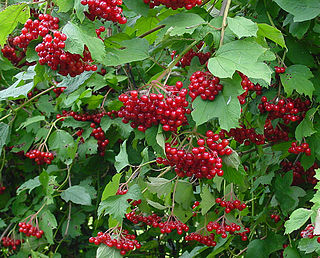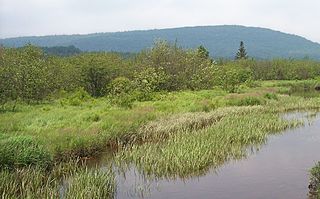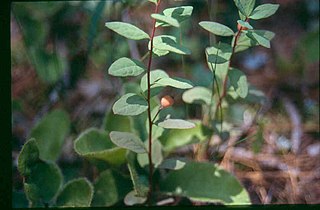Highbush cranberry is a common name for several plants and may refer to:
- Viburnum trilobum , American highbush cranberry
- Viburnum opulus , European highbush cranberry
- Viburnum edule , squashberry, native to North America
Highbush cranberry is a common name for several plants and may refer to:

Vaccinium is a common and widespread genus of shrubs or dwarf shrubs in the heath family (Ericaceae). The fruits of many species are eaten by humans and some are of commercial importance, including the cranberry, blueberry, bilberry (whortleberry), lingonberry (cowberry), and huckleberry. Like many other ericaceous plants, they are generally restricted to acidic soils.

Viburnum is a genus of about 150–175 species of flowering plants in the moschatel family Adoxaceae. Its current classification is based on molecular phylogeny. It was previously included in the honeysuckle family Caprifoliaceae.
Pembina is an Algonquian term for a species of Viburnum, the low-bush cranberry or squash berry.
Mossberry is a common name for several plants and may refer to:
Snowball bush is a common name for several ornamental plants which produce large clusters of white flowers and may refer to:

Viburnum opulus is a species of flowering plant in the family Adoxaceae native to Europe, northern Africa and central Asia.

Vaccinium corymbosum, the northern highbush blueberry, is a North American species of blueberry which has become a food crop of significant economic importance. It is native to eastern Canada and the eastern and southern United States, from Ontario east to Nova Scotia and south as far as Florida and eastern Texas. It is also naturalized in other places: Europe, Japan, New Zealand, the Pacific Northwest of North America, etc. Other common names include blue huckleberry, tall huckleberry, swamp huckleberry, high blueberry, and swamp blueberry.

Viburnum trilobum is a species of Viburnum native to northern North America, from Newfoundland west to British Columbia, south to Washington state and east to northern Virginia. It is very closely related to the European and Asian Viburnum opulus, and is often treated as a variety of it, as Viburnum opulus L. var. americanum Ait., or as a subspecies, Viburnum opulus subsp. trilobum (Marshall) Clausen.
Black haw is a common name for several woody plants and may refer to:
Possumhaw is a common name for several plants and may refer to:
Sweet viburnum may refer to:

Blueberries are perennial flowering plants with blue or purple berries. They are classified in the section Cyanococcus within the genus Vaccinium. Vaccinium also includes cranberries, bilberries, huckleberries and Madeira blueberries. Commercial blueberries—both wild (lowbush) and cultivated (highbush)—are all native to North America. The highbush varieties were introduced into Europe during the 1930s.
Lowbush cranberry is a common name for several flowering plants and may refer to:

Viburnum edule, the squashberry, mooseberry, moosewood viburnum, highbush cranberry, or lowbush cranberry is a species of shrub native to Canada and the northern parts of the US.

Shrub swamps — also called scrub swamps or buttonbush swamps — are a type of freshwater wetland ecosystem occurring in areas too wet to become swamps, but too dry or too shallow to become marshes. They are often considered transitional (“mid-successional”) between wet meadows or fens and conifer or hardwood swamps.

Vaccinium caesariense is native to the Eastern United States. It is a species in the genus Vaccinium, which includes blueberries, cranberries, huckleberry, and bilberries.

Geocaulon is a monotypic genus of flowering plants in the family Santalaceae containing the single species Geocaulon lividum, which is known by the common names northern comandra and false toadflax. It is native to northern North America, where it is common and widespread from Alaska to Newfoundland and into the northernmost contiguous United States.
Elymus macrourus is a species of grass known by the common names tufted wheatgrass and thickspike wildrye. It is native to northwestern North America in Alaska, Yukon, and the Northwest Territories. It is also present in eastern Siberia.

Rubus canadensis is a North American species of flowering plant in the rose family known by the common names smooth blackberry, Canadian blackberry, thornless blackberry and smooth highbush blackberry. It is native to central and eastern Canada and the eastern United States.

Triangle Lake Bog or Triangle Lake Bog State Nature Preserve is a 61-acre (25 ha) state nature preserve in the U.S. state of Ohio. It is located in Rootstown Township, south of Ravenna.